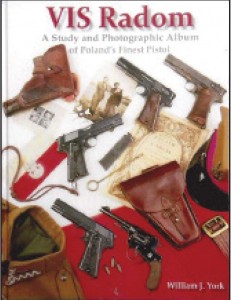Review by Larry S. Sterett | Contributing Editor
VIS Radom A Study and Photographic Album of Poland’s Finest Pistol, by William J. York. ©2011. Published by Wet Dog Publications, Dept. TGM, 5603-B West Friendly Avenue, Suite 166, Greensboro, NC 27410. Price: $57.95, plus postage. Mention this review when ordering and receive an autographed copy and free shipping.
 This 256-page hardbound volume is long overdue. It is the ultimate book on one of the best and least known autoloading European pistols of the World War II era. The German Walther P-38 was in the limelight, but the original VIS Radom was the better of the two. (After Germany occupied Poland in 1939, they soon took over the manufacture of the VIS pistol. Manufacturing shortcuts were soon implemented to speed up production, and the quality of the pistol suffered as a result.)
This 256-page hardbound volume is long overdue. It is the ultimate book on one of the best and least known autoloading European pistols of the World War II era. The German Walther P-38 was in the limelight, but the original VIS Radom was the better of the two. (After Germany occupied Poland in 1939, they soon took over the manufacture of the VIS pistol. Manufacturing shortcuts were soon implemented to speed up production, and the quality of the pistol suffered as a result.)
A work of this quality requires a lot of assistance, and the acknowledgments for such help are the first order in this excellent volume. Then follow 20 chapters, from Poland’s Pistol-A Historical Overview, to the Bibliography, of quality information, with hundreds of photographs, on the VIS Radom pistol. (There is no index.)
Many historical documents, including production drawings, etc., are illustrated, often with English translations provided, and wartime photographs are many. In addition, serial number ranges for the pistols produced from 1936–1939 are listed, with notes on the pistols produced under German occupation. (The quality of the wartime photos is a bit fuzzy in some instances, but they still provide detail considering their age. New photographs, the majority of which were taken by A. Vanderlinden, are excellent, with details sharp and clean.)
Accessories—holsters, lanyards, cleaning kits, etc., for the VIS, sometimes referred to as the P–35, are discussed and illustrated. Prewar and early wartime VIS pistols have the mainspring housing milled for the attachment of a shoulder stock. However, no original VIS holster stocks are known to exist, but a few such shoulder stocks based on the original plans were produced several years ago. These stocks resembled those produced for the various Mauser and Browning Hi-Power pistols, but some non-holster, slab-sided stocks are also known.
Photos illustrating the step-by-step take-down procedures for the VIS are provided, along with comments for detail stripping of various parts. For anyone not familiar with the VIS, this information can be extremely valuable. There are also comments on collecting the VIS, with hints on watching for counterfeits.
The final six chapters preceding the Bibliography are designated as Photography Galleries. They highlight examples of the VIS Radom pistol from one of the prototypes to pistols of the Polish Underground, plus non-VIS handguns and rifles produced at Radom. The quality of the photographs is excellent, and details, such as proof, inspector or acceptance marks are sharp, even the grain in the leather holsters is visible. (Firearms other than the VIS have been produced at Radom. Nagant M1895 revolvers, TT33 Tokarev pistols, including a .22 rimfire version, P64 and P83 pistols chambered for the 9mm Makarov cartridge, and the MAG95 bear the Radom markings. Then there are the rifles based on the ’98 Mauser design, and a prewar prototype gas-operated M1938 autoloading rifle that might have enjoyed a big market in the U.S., if…
VIS Radom has been needed for decades. It is The Book on the subject, with information and photographs never before seen in print. This reviewer first came across the Radom in the 1943 edition of W.H.B. Smith’s Small Arms of the World.
Unfortunately, it has taken decades for the real information to see print, but W.J. York’s tome, with photographs by Anthony Vanderlinden, and others, has been worth the wait.



